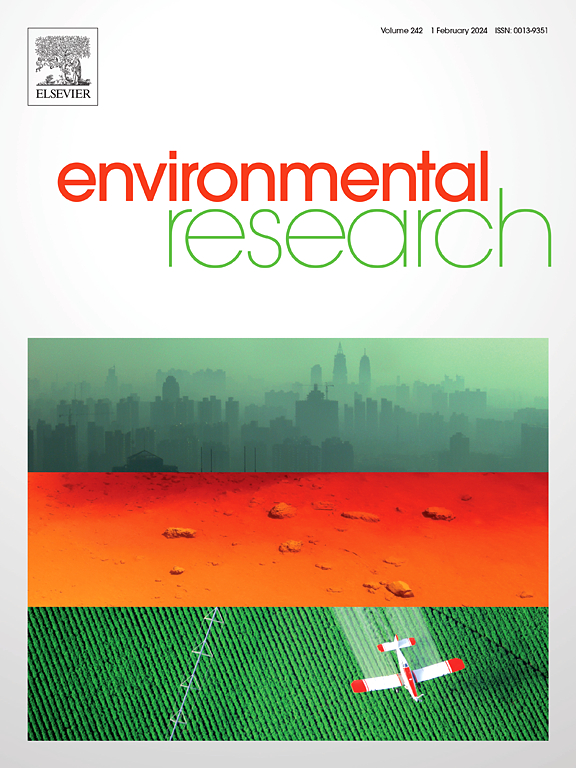Dual-pathway reactive species evolution over novel N-doped Bi9O13.5Cl2/g-C3N4 scaffolding heterojunction: Investigation of dark and light-induced micropollutant decomposition
IF 7.7
2区 环境科学与生态学
Q1 ENVIRONMENTAL SCIENCES
引用次数: 0
Abstract
The mechanism underlying reactive species (RSs) evolution in photo-based advanced oxidation processes (AOPs) under continuous conditions has not been well characterized and investigated in the existing scientific literatures. A scaffolding heterojunction comprising N-doped graphitic carbon nitride with novel Bi9O13.5Cl2 photocatalyst (NBCN) was successfully fabricated, achieving 96.7 % for TC degradation compared to 63.4 % for non-doped BCN. Comprehensive characterization analyses demonstrated exceptional charge-carrier separation dynamic through composite heterojunction. Under illuminated conditions, we identified two main RSs formation routes: an O2-mediated pathway and a h + -mediated pathway. Comparative kinetic analysis revealed the critical role of O2 activation, showing a remarkable 6.2-fold enhancement in kinetic rate constant for organic pollutant degradation under O2-ambient condition (k = 3.1 × 10−2 min−1) compared to the anaerobic environment (k = 5 × 10−3 min−1). Primary RSs were identified and ranked in order of significance as 1O2 > •O2− > h+ > •OH. Theoretical calculations further revealed that the promoted photocatalytic performance was achieved through favorable adsorption energy, promoted electron redistribution by N-doping and well-defined formation pathways of O2-mediated RSs. Under dark conditions, significant amounts of dark-generated h+ were detected in NBCN, where its hydrophilic nature facilitated the formation of transient •OH. The practical applicability of the system was validated through real water matrix tests, highlighting the robust performance of the O2 activation and 1O2 production. By elucidating the mechanism of continuous contaminant degradation under entire round-the-clock scenarios, this study advances the development of sustainable environmental remediation technologies in low temperature environment across various water matrices.

新型n掺杂Bi9O13.5Cl2/g-C3N4脚手架异质结的双途径反应物种进化:暗和光诱导微污染物分解的研究。
在现有的科学文献中,对连续条件下光基高级氧化过程(AOPs)中反应物质(RSs)演化的机制尚未进行很好的表征和研究。采用新型Bi9O13.5Cl2光催化剂(NBCN)成功制备了含n掺杂石墨氮化碳的支架异质结,其对TC的降解率为96.7%,而未掺杂BCN的降解率为63.4%。综合表征分析表明,复合异质结具有特殊的电荷-载流子分离动态。在光照条件下,我们确定了两种主要的RSs形成途径:o2介导的途径和h+介导的途径。对比动力学分析揭示了O2活化的关键作用,O2环境条件下(k = 3.1 × 10-2 min-1)有机污染物降解的动力学速率常数比厌氧环境(k = 5 × 10-3 min-1)提高了6.2倍。主要RSs被确定,并按显著性排序为1O2 >•O2- >h+ >•OH。理论计算进一步表明,提高光催化性能是通过良好的吸附能、n掺杂促进电子重分布和明确的o2介导RSs形成途径来实现的。在暗条件下,在NBCN中检测到大量暗生成的h+,其亲水性促进了瞬态•OH的形成。通过实际水基质测试验证了该系统的实用性,突出了O2活化和1O2生产的稳健性能。本研究通过阐明全天候情况下污染物持续降解的机制,推动了跨不同水基质的低温环境可持续环境修复技术的发展。
本文章由计算机程序翻译,如有差异,请以英文原文为准。
求助全文
约1分钟内获得全文
求助全文
来源期刊

Environmental Research
环境科学-公共卫生、环境卫生与职业卫生
CiteScore
12.60
自引率
8.40%
发文量
2480
审稿时长
4.7 months
期刊介绍:
The Environmental Research journal presents a broad range of interdisciplinary research, focused on addressing worldwide environmental concerns and featuring innovative findings. Our publication strives to explore relevant anthropogenic issues across various environmental sectors, showcasing practical applications in real-life settings.
 求助内容:
求助内容: 应助结果提醒方式:
应助结果提醒方式:


